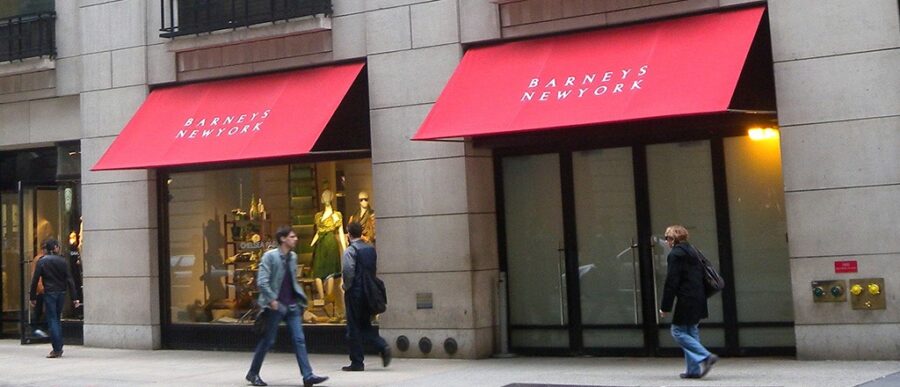Another retail icon has fallen. Barneys New York announced earlier this month that it has filed for Chapter 11 bankruptcy protection as it struggles with more than $100 million in debt, rising rents and increased competition in the luxury market.
The company will close stores in Chicago, Seattle, Las Vegas and other cities to focus on its flagship location on Madison Avenue in New York, where the yearly rent nearly doubled in January to $30 million. The rent hike nearly wipes out earnings before interest, taxes, depreciation and amortization, according to CNBC.com.
“Like many in our industry, Barneys New York’s financial position has been dramatically impacted by the challenging retail environment and rent structures that are excessively high relative to market demand,” CEO Daniella Vitale said in a statement.
Barneys, which is controlled by hedge fund Perry Capital, is the latest light to dim in the bleak landscape for brick-and-mortar retailers. Coresight Research estimates some 12,000 stores will close by the end of 2019, far surpassing the 5,864 that shuttered in 2018. News about Barneys, which has spent nearly a century as an arbiter of style for well-heeled New Yorkers, highlights the pressing problems retailers face from a fragmenting consumer market and skyrocketing rents in red-hot locations like Manhattan.
“This is a booming period for commercial real estate,” Wharton real estate professor Benjamin Keys said. “We’ve seen for many years, coming out of the Great Recession, that rents have risen for a lot of retail in desirable spots. That’s not true of the second-tier and third-tier malls that are in outlying areas — we’ve heard so much about their closures. But this is the flip side to that — the places where there is still quite a bit of foot traffic and still a lot of demand for physical space.”
Thomai Serdari, an expert on the luxury segment and adjunct marketing professor at New York University’s Stern School of Business, agreed that the old adage about location is still what drives up rent. But there’s another weight adding to the burden of retailers such as Barneys.
“We’ve seen for many years, coming out of the Great Recession, that rents have risen for a lot of retail in desirable spots.” –Benjamin Keys
“The issue here is the marketing strategy that a lot of these retailers are applying,” she said. “The gap is between having foot traffic and having activations that actually convert the [desirable location] to purchases, and I think this is where a lot of these retailers miss out. This is why we see such a high turnover, even on Madison Avenue, with retailers coming in for 18 months, for three years, and then disappearing from the map entirely.”
Serdari and Keys recently spoke on the Knowledge at Wharton radio show on SiriusXM about the Barneys bankruptcy, rising commercial rents and the implications for the retail industry. (Listen to the podcast at the top of this page.)
Presence in an Important Market
New York “is in another league when it comes to commercial real estate prices in the United States,” Keys noted. Barney’s decision to keep the Manhattan store despite the astronomical rent indicates the company’s belief in it.
“This is a strong signal that Barneys sees a lot of value in that flagship store, that it’s probably their most profitable physical location,” he said. “To whatever extent they’re going to develop a broader online presence, they want to keep that flagship there as a way to signal their presence in the most important market in the U.S.”
But Serdari offered another perspective on the company’s decision. Taking what she described as “the elitist view,” Serdari said Barneys is willing to pay top dollar to keep the doors open in Manhattan because of the shoppers. Luxury consumers in New York are different than those in Chicago, Las Vegas or Seattle. They are the style-setters, she said.
The U.S. is “basically a very big market in terms of volume, in terms of [social media] followers,” Serdari noted. Social media influencers may promote the items they find in luxury stores, and large numbers of shoppers who look to them as style guides flock to purchase those items. “And that happens usually in big metropolitan areas,” she said. “New York, of course, is the frontrunner in that, and that’s why all the flagships want to be here.”
Keys noted that placing the focus on influencers broadens the real estate issue to the global scene, because New York is not the only place where trendsetters exist. “The question becomes: Who is New York competing with?” Global real estate investors might also be considering places like Tokyo, Paris and London, because “these trendsetter locations are maybe the only ones that can sustain these luxury brands.”
A second issue is the disposition of real estate that is increasingly being abandoned by luxury brands, he added. For example, WeWork, a company that rents office space, purchased the Fifth Avenue location occupied for more than 100 years by Lord & Taylor, which shuttered that property in January.
“These luxury brands tended to locate in very expensive and very desirable spots in the other major cities in the U.S., and that’s space that’s still in high demand, where rents are high,” he said. “I think there’s going to be an interesting repositioning there when you’re thinking about other retail that could move in. But you’re also seeing the rise of office demand.” What’s more, Keys noted, whereas retailers need to turn real estate presence into sales, offices do not face the pressure to do that.
A Changing Market
If the real estate market is changing, so is the luxury market. Serdari pointed out that luxury consumers are sophisticated and well-informed. They want value, too, and they’ve grown weary of the over-expansion of stores, which they find “a little vulgar,” she said. That’s why many luxury consumers are more than willing to follow their favorite brands to more intimate stores in second-tier locations around the corner from a main thoroughfare like New York’s Madison Avenue or Chicago’s Miracle Mile.
“We need to remember that this exact model of floor after floor after floor was implemented in the late 19th century, so it had a pretty good run of about 150 years.” –Thomai Serdari
In addition to rent hikes, Barneys and other legacy department stores face a financial crunch from falling sales due to the onslaught of competition — online and otherwise. Many luxury brands are selling on their own websites, and a number of luxury platforms, such as Moda Operandi and Net-A-Porter, have popped up to ferry business away from brick-and-mortar stores. In other words, brands no longer need department stores to generate volume sales as they once did.
“The entire industry is in survival mode,” Vitale of Barneys New York said, according to a recording obtained by CNBC. “The model is not working, it’s not working for Neiman [Marcus], it’s not working for Saks, it’s not working for us, it’s not working for Nordstrom.”
According to Serdari, the struggles are a reminder that the department store — once a venerated institution in the American retail industry — must re-invent itself.
“We need to remember that this exact model of floor after floor after floor was implemented in the late 19th century, so it had a pretty good run of about 150 years,” she said. “Here we are in almost 2020, having made tremendous advances in technology that have educated us and trained us to shop in a different way, so the concept of the department store needs to change.”
She doesn’t think department stores will disappear entirely, but decreasing their real estate footprints and re-imaging their spaces are good places to start. They also need time for their new strategies to work.
“If your private equity investor is forcing you to have results every quarter, the same way as if you were a publicly traded company, you cannot do it and you will fail again,” Serdari said. “If a private equity investor understands how luxury works and knows how to segment the market correctly, they will give you a longer runway to actually implement the strategy and be a winner. But it’s not going to be in three or five years. It’s going to be in 10 years.”



